Fan Lu
LiDARDraft: Generating LiDAR Point Cloud from Versatile Inputs
Dec 23, 2025

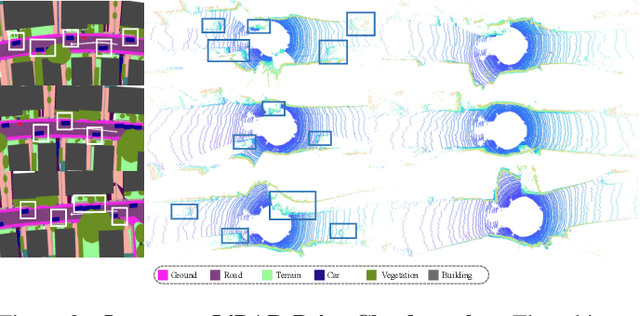

Abstract:Generating realistic and diverse LiDAR point clouds is crucial for autonomous driving simulation. Although previous methods achieve LiDAR point cloud generation from user inputs, they struggle to attain high-quality results while enabling versatile controllability, due to the imbalance between the complex distribution of LiDAR point clouds and the simple control signals. To address the limitation, we propose LiDARDraft, which utilizes the 3D layout to build a bridge between versatile conditional signals and LiDAR point clouds. The 3D layout can be trivially generated from various user inputs such as textual descriptions and images. Specifically, we represent text, images, and point clouds as unified 3D layouts, which are further transformed into semantic and depth control signals. Then, we employ a rangemap-based ControlNet to guide LiDAR point cloud generation. This pixel-level alignment approach demonstrates excellent performance in controllable LiDAR point clouds generation, enabling "simulation from scratch", allowing self-driving environments to be created from arbitrary textual descriptions, images and sketches.
Vision-Centric Activation and Coordination for Multimodal Large Language Models
Oct 16, 2025Abstract:Multimodal large language models (MLLMs) integrate image features from visual encoders with LLMs, demonstrating advanced comprehension capabilities. However, mainstream MLLMs are solely supervised by the next-token prediction of textual tokens, neglecting critical vision-centric information essential for analytical abilities. To track this dilemma, we introduce VaCo, which optimizes MLLM representations through Vision-Centric activation and Coordination from multiple vision foundation models (VFMs). VaCo introduces visual discriminative alignment to integrate task-aware perceptual features extracted from VFMs, thereby unifying the optimization of both textual and visual outputs in MLLMs. Specifically, we incorporate the learnable Modular Task Queries (MTQs) and Visual Alignment Layers (VALs) into MLLMs, activating specific visual signals under the supervision of diverse VFMs. To coordinate representation conflicts across VFMs, the crafted Token Gateway Mask (TGM) restricts the information flow among multiple groups of MTQs. Extensive experiments demonstrate that VaCo significantly improves the performance of different MLLMs on various benchmarks, showcasing its superior capabilities in visual comprehension.
UrbanCraft: Urban View Extrapolation via Hierarchical Sem-Geometric Priors
May 29, 2025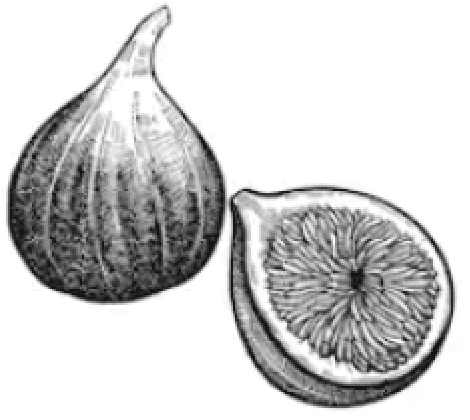
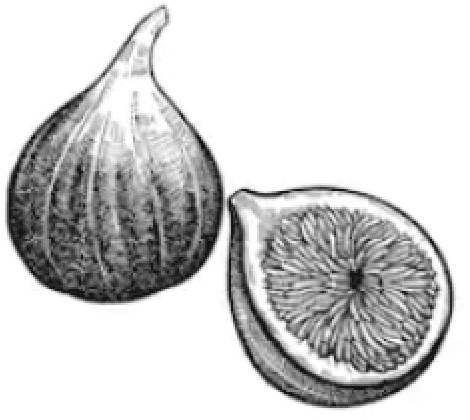
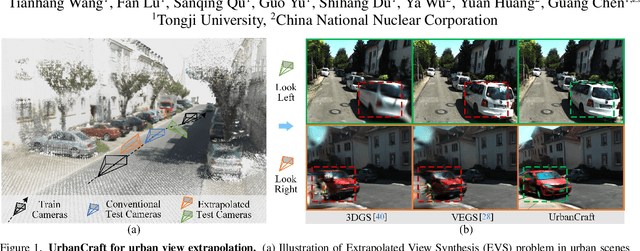

Abstract:Existing neural rendering-based urban scene reconstruction methods mainly focus on the Interpolated View Synthesis (IVS) setting that synthesizes from views close to training camera trajectory. However, IVS can not guarantee the on-par performance of the novel view outside the training camera distribution (\textit{e.g.}, looking left, right, or downwards), which limits the generalizability of the urban reconstruction application. Previous methods have optimized it via image diffusion, but they fail to handle text-ambiguous or large unseen view angles due to coarse-grained control of text-only diffusion. In this paper, we design UrbanCraft, which surmounts the Extrapolated View Synthesis (EVS) problem using hierarchical sem-geometric representations serving as additional priors. Specifically, we leverage the partially observable scene to reconstruct coarse semantic and geometric primitives, establishing a coarse scene-level prior through an occupancy grid as the base representation. Additionally, we incorporate fine instance-level priors from 3D bounding boxes to enhance object-level details and spatial relationships. Building on this, we propose the \textbf{H}ierarchical \textbf{S}emantic-Geometric-\textbf{G}uided Variational Score Distillation (HSG-VSD), which integrates semantic and geometric constraints from pretrained UrbanCraft2D into the score distillation sampling process, forcing the distribution to be consistent with the observable scene. Qualitative and quantitative comparisons demonstrate the effectiveness of our methods on EVS problem.
R2LDM: An Efficient 4D Radar Super-Resolution Framework Leveraging Diffusion Model
Mar 21, 2025Abstract:We introduce R2LDM, an innovative approach for generating dense and accurate 4D radar point clouds, guided by corresponding LiDAR point clouds. Instead of utilizing range images or bird's eye view (BEV) images, we represent both LiDAR and 4D radar point clouds using voxel features, which more effectively capture 3D shape information. Subsequently, we propose the Latent Voxel Diffusion Model (LVDM), which performs the diffusion process in the latent space. Additionally, a novel Latent Point Cloud Reconstruction (LPCR) module is utilized to reconstruct point clouds from high-dimensional latent voxel features. As a result, R2LDM effectively generates LiDAR-like point clouds from paired raw radar data. We evaluate our approach on two different datasets, and the experimental results demonstrate that our model achieves 6- to 10-fold densification of radar point clouds, outperforming state-of-the-art baselines in 4D radar point cloud super-resolution. Furthermore, the enhanced radar point clouds generated by our method significantly improve downstream tasks, achieving up to 31.7% improvement in point cloud registration recall rate and 24.9% improvement in object detection accuracy.
Range and Bird's Eye View Fused Cross-Modal Visual Place Recognition
Feb 17, 2025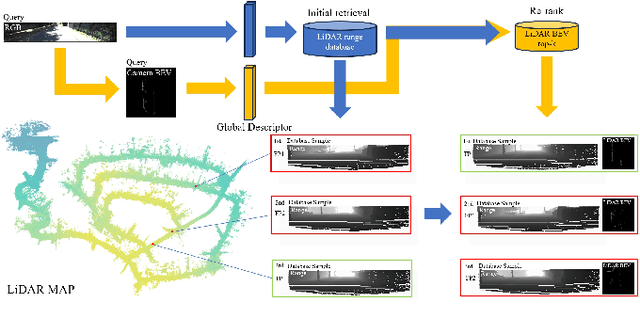

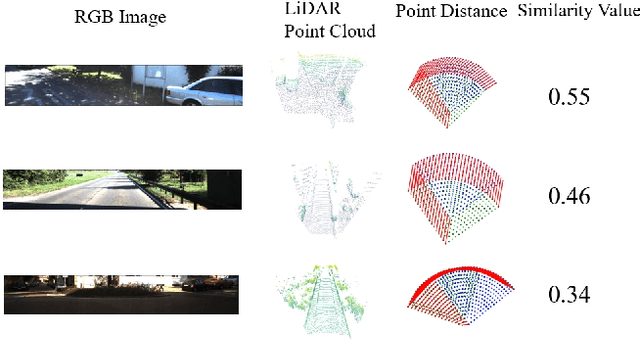
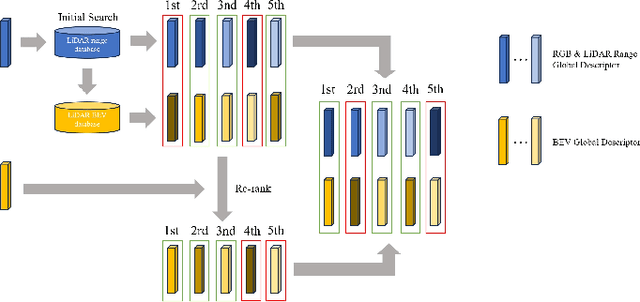
Abstract:Image-to-point cloud cross-modal Visual Place Recognition (VPR) is a challenging task where the query is an RGB image, and the database samples are LiDAR point clouds. Compared to single-modal VPR, this approach benefits from the widespread availability of RGB cameras and the robustness of point clouds in providing accurate spatial geometry and distance information. However, current methods rely on intermediate modalities that capture either the vertical or horizontal field of view, limiting their ability to fully exploit the complementary information from both sensors. In this work, we propose an innovative initial retrieval + re-rank method that effectively combines information from range (or RGB) images and Bird's Eye View (BEV) images. Our approach relies solely on a computationally efficient global descriptor similarity search process to achieve re-ranking. Additionally, we introduce a novel similarity label supervision technique to maximize the utility of limited training data. Specifically, we employ points average distance to approximate appearance similarity and incorporate an adaptive margin, based on similarity differences, into the vanilla triplet loss. Experimental results on the KITTI dataset demonstrate that our method significantly outperforms state-of-the-art approaches.
Benchmarking Large Vision-Language Models via Directed Scene Graph for Comprehensive Image Captioning
Dec 12, 2024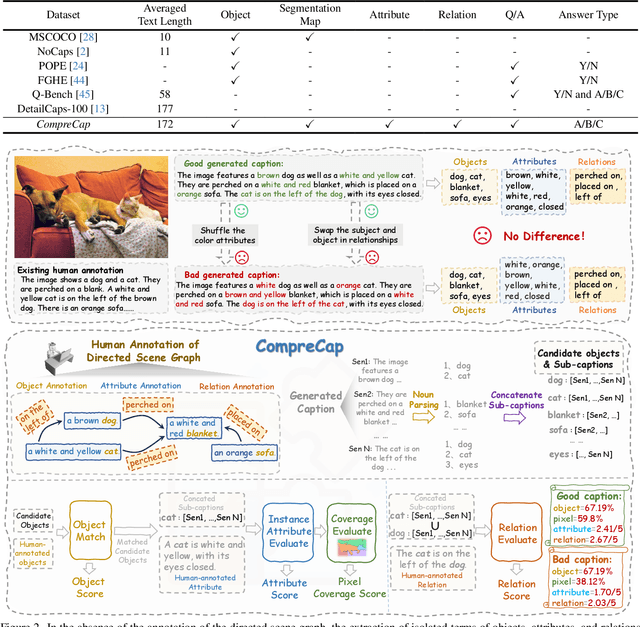
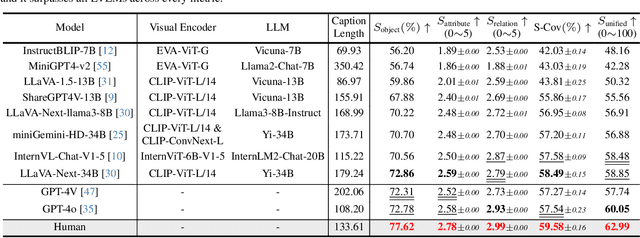
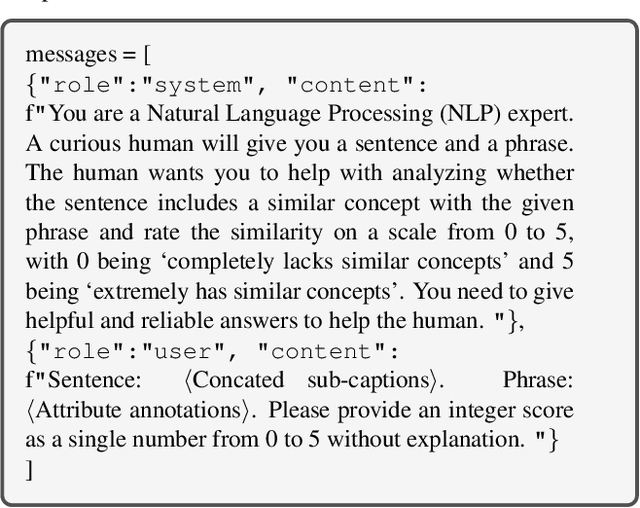
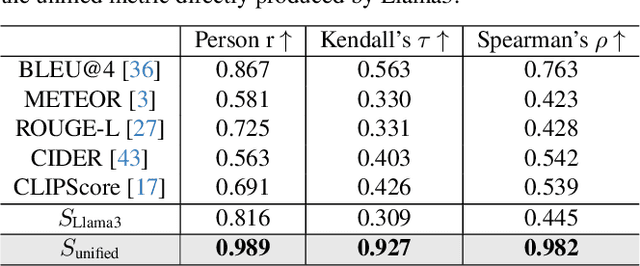
Abstract:Generating detailed captions comprehending text-rich visual content in images has received growing attention for Large Vision-Language Models (LVLMs). However, few studies have developed benchmarks specifically tailored for detailed captions to measure their accuracy and comprehensiveness. In this paper, we introduce a detailed caption benchmark, termed as CompreCap, to evaluate the visual context from a directed scene graph view. Concretely, we first manually segment the image into semantically meaningful regions (i.e., semantic segmentation mask) according to common-object vocabulary, while also distinguishing attributes of objects within all those regions. Then directional relation labels of these objects are annotated to compose a directed scene graph that can well encode rich compositional information of the image. Based on our directed scene graph, we develop a pipeline to assess the generated detailed captions from LVLMs on multiple levels, including the object-level coverage, the accuracy of attribute descriptions, the score of key relationships, etc. Experimental results on the CompreCap dataset confirm that our evaluation method aligns closely with human evaluation scores across LVLMs.
Learning Visual Generative Priors without Text
Dec 10, 2024



Abstract:Although text-to-image (T2I) models have recently thrived as visual generative priors, their reliance on high-quality text-image pairs makes scaling up expensive. We argue that grasping the cross-modality alignment is not a necessity for a sound visual generative prior, whose focus should be on texture modeling. Such a philosophy inspires us to study image-to-image (I2I) generation, where models can learn from in-the-wild images in a self-supervised manner. We first develop a pure vision-based training framework, Lumos, and confirm the feasibility and the scalability of learning I2I models. We then find that, as an upstream task of T2I, our I2I model serves as a more foundational visual prior and achieves on-par or better performance than existing T2I models using only 1/10 text-image pairs for fine-tuning. We further demonstrate the superiority of I2I priors over T2I priors on some text-irrelevant visual generative tasks, like image-to-3D and image-to-video.
GSGTrack: Gaussian Splatting-Guided Object Pose Tracking from RGB Videos
Dec 03, 2024
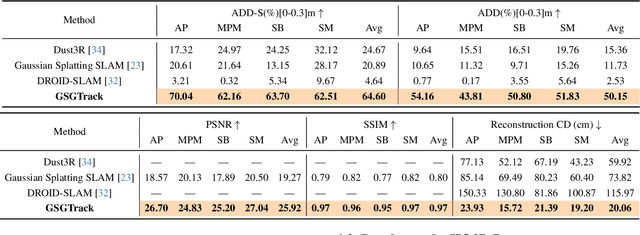
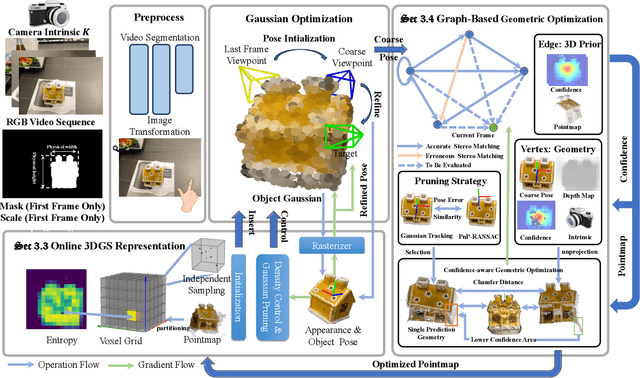
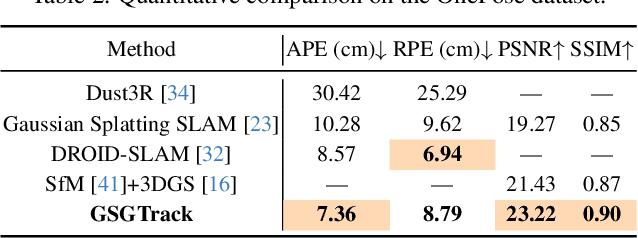
Abstract:Tracking the 6DoF pose of unknown objects in monocular RGB video sequences is crucial for robotic manipulation. However, existing approaches typically rely on accurate depth information, which is non-trivial to obtain in real-world scenarios. Although depth estimation algorithms can be employed, geometric inaccuracy can lead to failures in RGBD-based pose tracking methods. To address this challenge, we introduce GSGTrack, a novel RGB-based pose tracking framework that jointly optimizes geometry and pose. Specifically, we adopt 3D Gaussian Splatting to create an optimizable 3D representation, which is learned simultaneously with a graph-based geometry optimization to capture the object's appearance features and refine its geometry. However, the joint optimization process is susceptible to perturbations from noisy pose and geometry data. Thus, we propose an object silhouette loss to address the issue of pixel-wise loss being overly sensitive to pose noise during tracking. To mitigate the geometric ambiguities caused by inaccurate depth information, we propose a geometry-consistent image pair selection strategy, which filters out low-confidence pairs and ensures robust geometric optimization. Extensive experiments on the OnePose and HO3D datasets demonstrate the effectiveness of GSGTrack in both 6DoF pose tracking and object reconstruction.
LoTLIP: Improving Language-Image Pre-training for Long Text Understanding
Oct 07, 2024



Abstract:Understanding long text is of great demands in practice but beyond the reach of most language-image pre-training (LIP) models. In this work, we empirically confirm that the key reason causing such an issue is that the training images are usually paired with short captions, leaving certain tokens easily overshadowed by salient tokens. Towards this problem, our initial attempt is to relabel the data with long captions, however, directly learning with which may lead to performance degradation in understanding short text (e.g., in the image classification task). Then, after incorporating corner tokens to aggregate diverse textual information, we manage to help the model catch up to its original level of short text understanding yet greatly enhance its capability of long text understanding. We further look into whether the model can continuously benefit from longer captions and notice a clear trade-off between the performance and the efficiency. Finally, we validate the effectiveness of our approach using a self-constructed large-scale dataset, which consists of 100M long caption oriented text-image pairs. It is noteworthy that, on the task of long-text image retrieval, we beat the competitor using long captions with 11.1% improvement (i.e., from 72.62% to 83.72%). We will release the code, the model, and the new dataset to facilitate the reproducibility and further research. The project page is available at https://wuw2019.github.io/lotlip.
GeoNLF: Geometry guided Pose-Free Neural LiDAR Fields
Jul 08, 2024Abstract:Although recent efforts have extended Neural Radiance Fields (NeRF) into LiDAR point cloud synthesis, the majority of existing works exhibit a strong dependence on precomputed poses. However, point cloud registration methods struggle to achieve precise global pose estimation, whereas previous pose-free NeRFs overlook geometric consistency in global reconstruction. In light of this, we explore the geometric insights of point clouds, which provide explicit registration priors for reconstruction. Based on this, we propose Geometry guided Neural LiDAR Fields(GeoNLF), a hybrid framework performing alternately global neural reconstruction and pure geometric pose optimization. Furthermore, NeRFs tend to overfit individual frames and easily get stuck in local minima under sparse-view inputs. To tackle this issue, we develop a selective-reweighting strategy and introduce geometric constraints for robust optimization. Extensive experiments on NuScenes and KITTI-360 datasets demonstrate the superiority of GeoNLF in both novel view synthesis and multi-view registration of low-frequency large-scale point clouds.
 Add to Chrome
Add to Chrome Add to Firefox
Add to Firefox Add to Edge
Add to Edge